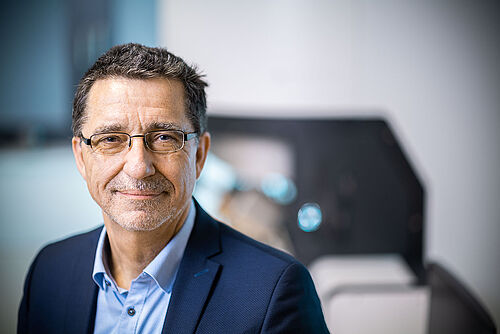In addition to the epitaxy setups, the complete process chain for fabricating semiconductor devices is available inside the Institute’s cleanroom laboratory. For patterning we have several lithography methods at hand, mostly used are photolithography and nanoimprint lithography. GaN can be etched by wet chemistry or by dry etching in an RIE-ICP (Reactive Ion Etching by Inductively Coupled Plasma). Both methods are used for the deep etching of 3-dimensional GaN architectures (see “Deep Etching”). We can use Rapid Thermal Annealing (RTA) for p-GaN activation or contact annealing. By an e-beam evaporation system we can deposit metal contacts (e.g. Ti or Au) or insulating layers (e.g. SiOx). We have an Atomic Layer Deposition (ALD) for coating samples with very thin and highly conformal layers of SiO2, ZnO or Al2O3. By a wafer saw we can separate single chips from the processed wafers. The Laser-Lift-Off (LLO) setup opens up further possibilities for GaN and sapphire processing.
Laser machining of nitride semiconductors and sapphire substrates
Modern laser technology provides high-power beams at high beam quality which can be utilized for efficient and accurate material processing. In our LENA optics lab an industrial-grade pulsed solid state laser is available. It provides pulse widths between 300 fs and 10 ps at a repetition rate of 200 kHz and a fundamental wavelength of 1040 nm. The ultra-short pulses limit the energy transfer to the crystal lattice during laser processing. That means that the heat-affected zone turns out to be small in comparison to the nanosecond and cw regime. By frequency conversion, shorter wavelengths of 520 and 348 nm can also be generated for different material processing steps.
The laser beam can be focussed onto the sample surface by different objectives. Scanning along the surface can either be realized by a galvanometer scanner, which rapidly deflects the beam by tiltable mirrors, or by moving the sample on a xy-positioner. Equipped with a powerful software, fully automated recipe sequences can be run.
Currently, two main research aspects are explored. On the one hand, the system is used for a LLO process of GaN-based LEDs from sapphire. Sapphire has been established as a reliable and cheap substrate for epitaxial growth of functional GaN layers. However, for certain applications as high-power or structured LEDs, other substrates, e.g., metals or non-transparent semiconductors, are more favourable. By directing strong laser pulses to the backside of the sapphire, the LED film can be separated from the carrier by local evaporation of an intermediate layer between device and substrate. We have recently demonstrated that this process, which is usually conducted with nanosecond pulsed excimer lasers, can be realized with ultrashort pulses at 520 nm.
On the other hand, the system is used for direct structuring of sapphire substrates. µLEDs produced at the Institute are commonly designed as bottom-emitters, i. e. the main direction of light emission is through the underlying sapphire substrate. For efficient use, e. g. coupling into a fibre, it may be beneficial to reduce the sapphire thickness. For this purpose laser-based pre-structuring of the sapphire wafers with high precision from the backside is applied before the epitaxial GaN growth of the device layers. Moreover, the setup can be used for chip separation as the last step in the production chain.
Contact: Jana Hartmann
